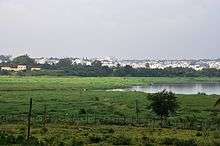Bellandur Lake
| Bellandur Lake ಬೆಳ್ಳಂದೂರು ಕೆರೆ/ಕೊಳ/ಹಳ್ಳ | |
|---|---|
 | |
| Location | Bellandur, Bengaluru, Karnataka, India |
| Coordinates | 12°56′3″N 77°39′46″E / 12.93417°N 77.66278°ECoordinates: 12°56′3″N 77°39′46″E / 12.93417°N 77.66278°E |
| Type | Lake |
| Primary outflows | Varthur Lake |
| Catchment area | 148 km2 (57 sq mi) |
| Max. length | 3.6 km (2.2 mi) |
| Max. width | 1.4 km (0.87 mi) |
| Surface area | 3.61 km2 (1.39 sq mi) |
| Average depth | 9.21 m (30.2 ft) |
| Frozen | Never |
| Settlements | Bangalore |
Bellandur Lake is a lake in the suburb of Bellandur in the southeast of the city of Bengaluru and is the largest lake in the city. It is a part of Bellandur drainage system that drains the southern and the south-eastern parts of the city. The lake is a receptor from three chains of lakes upstream, and has a catchment area of about 148 square kilometres (37,000 acres). Water from this lake flows further east to the Varthur Lake, from where it flows down the plateau and eventually into the Pinakani river basin.[1] It is currently highly polluted with sewage, and in May 2015 the foam covering the water surface caught fire and burned for hours.
The lake caught fire again in January 2018.[2]
Geography
Bellandur Lake is believed to be originally a tributary of the Dakshina Pinakini river (also known as the Ponnaiyar River). The lake itself was constructed during the reign of the Western Ganga Dynasty who ruled between the 4-5th century to 10th century CE. Evidences of early human settlement have been excavated along the bed of the Bellandur lake by historian Dr. PV Krishnamurthy. [3]
Bellandur Lake is a major water body which is located in one of the three main valleys of Bengaluru. It forms a part of the Ponnaiyar River catchment, and water from Bellandur flows to Varthur Lake, ultimately joining the Pennar River. Currently, most of Bengaluru's treated and untreated sewage is released into Bellandur Lake, severely polluting it, resulting in a depletion of wildlife in and around the lake. Residential and commercial activities in the region have resulted in increasing the silt deposition in the lake and have caused loss of underground water recharge.[4]
Flora and fauna
The lake was a prominent catchment area with a good green cover and was a watering hole for the region's numerous, indigenous wildlife. But 30 years of unplanned urbanization have taken a toll on the lake, now several species are gone from the area, including kingfishers, parrots, parakeets, wood pigeons, kites, cobras, rat snakes, monitor lizards. As more and more large apartment complexes come up on the lakes shores, more such species will disappear.
Impact of urbanisation

The land around the lake is used as a dumping ground by builders and housing societies in the area. Since the early 2000s, nearby areas have been dumping untreated sewage and industrial waste into the lake unchecked.[5] The combination of all these factors has led to a decline in the once robust ecosystem of the lake which now resembles a stinking cesspool. Residents in neighboring areas complain of an odious stench that rises from the lake as a result of uninhibited sewage and chemical dumping from near by industrial units.[1] The presence of industrial chemicals in the water causes the lake surface to catch fire regularly.[6]

Conservation
Time and again the Bengaluru government has attempted to take positive action to save the lake, but in the end, the maximum efforts come from only from the citizens who plan plantation drives and cleanup programs around the lake. RTI activists like CH Ram have repeatedly brought the Lake's plight to the BBMP's attention, and have been promised affirmative action to save the lake. In 2010, the BBMP adopted a Lake Rejuvenation Program. Under this program, the lake received new fencing around its perimeter, only a few saplings were planted and the lake was cleaned up. In 2015, led by IT employee Sanchita Jha, a multi-front online campaign[7][8] was raised by people of the city, with around fifty thousand petitioners, gaining wide-scale media attention and forcing the CM to direct the authorities to draw up an action plan. However, the sewage treatment plants and small industries that dispel their wastes into the lake, have still not been stopped and so the lake's main problems still continue. [9] [10]
In March 2017, the state government invited experts from the UK and Israel to help resolve environmental issues.[11]
References
- 1 2 "Bellandur Lake". www.RainwaterHarvesting.org. Retrieved 15 January 2018.
- ↑ Abraham, Mary-Rose (14 February 2018). "Why This Lake Keeps Catching on Fire". National Geographic. Retrieved 12 April 2018.
- ↑ "Bellandur lake on fire: 10 facts to know about this heritage lake". AsianetNews.tv. Retrieved 15 January 2018.
- ↑ "Analyze and highlight Bellandur lake issues - Praja". www.Praja.in. Retrieved 15 January 2018.
- ↑ "Stop sewage flow into Bellandur Lake: National Green Tribunal". NewIndiaEexpress.com. Retrieved 15 January 2018.
- ↑ Devlin, Megan; Joseph, Rohit; Mallikarjunan, Prabhu; Majumdar, Romita; Sutton, Tara (28 May 2017). "The urban farmers battling Bangalore's concrete jungle". BBC. Retrieved 28 May 2017.
- ↑ "Why a Bellandur lake campaign by Bengaluru IT employee is picking pace". TheNewsMinute.com. 6 October 2015. Retrieved 15 January 2018.
- ↑ "Campaign for Bellandur Lake Gets Online Support". NewIndianExpress.com. Retrieved 15 January 2018.
- ↑ "Bellandur Lake". www.CommonFloor.com. Retrieved 15 January 2018.
- ↑ "New lease of life for Bellandur Lake". Deccan Herald. Retrieved 15 January 2018.
- ↑ "Bengaluru, Shamed By Frothing Lake, Summons International Help". NDTV.com. Retrieved 24 March 2017.
External links
